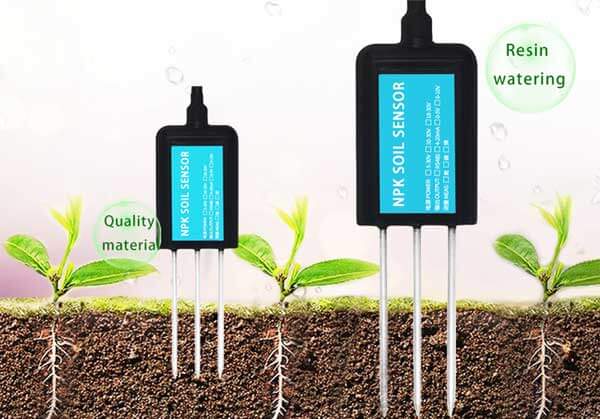Soil sensors play a pivotal role in modern agriculture, environmental monitoring, and research by providing real-time data on key soil parameters essential for plant growth, nutrient management, and soil health assessment. These advanced devices employ cutting-edge technology to measure various soil characteristics, because enabling farmers, researchers, and environmentalists to make informed decisions regarding irrigation, fertilization, and land use practices. In this comprehensive article

Monitoring Aspects of Soil Sensors:
Soil Moisture Monitoring:
Soil moisture is a critical factor influencing plant growth, root development, and water uptake efficiency.
Soil Temperature Monitoring:
Soil temperature directly affects biological processes, microbial activity, nutrient availability,because and plant development in the soil ecosystem.
Soil pH Monitoring:
Soil pH plays a crucial role in nutrient availability, microbial activity, and plant nutrient uptake efficiency. Soil sensors equipped with pH electrodes or probes measure the acidity or alkalinity levels of the soil,
Soil Nutrient Monitoring:
Soil sensors capable of measuring key nutrients such as nitrogen, phosphorus, potassium, and micronutrients provide essential information for nutrient management and fertilization practices.
Soil Salinity Monitoring:
Soil salinity, caused by excessive salt accumulation, can have detrimental effects on plant growth, soil structure, and water infiltration. Soil sensors with electrical conductivity probes or sensors measure soil salinity levels, guiding users in mitigating salinity stress through proper irrigation management and soil remediation techniques. Monitoring soil salinity helps prevent crop damage,
Soil Compaction Monitoring:
Soil compaction, resulting from heavy machinery, traffic, or natural processes, negatively impacts root penetration, water infiltration, and nutrient uptake in the soil. Soil sensors equipped with penetrometers or pressure sensors assess soil compaction levels by measuring soil resistance or bulk density. Monitoring soil compaction aids users in identifying compacted areas, implementing soil aeration practices,
Soil Respiration Monitoring:
Soil respiration, the release of carbon dioxide by soil organisms during microbial activity, serves as an indicator of soil health, organic matter decomposition, and nutrient cycling processes. Soil sensors utilizing gas sensors or infrared technology measure soil respiration rates, reflecting microbial activity levels and soil biological functioning. Monitoring soil respiration provides insights into soil fertility,
Types of Soil Sensors:
Capacitive Soil Moisture Sensors:
Capacitive soil moisture sensors measure soil moisture content based on changes in capacitance resulting from water presence in the soil. These sensors offer high accuracy, low power consumption, and durability,
Tensiometers:
Tensiometers, also known as soil water potential sensors, measure soil moisture tension or suction to indicate the energy required for plants to extract water from the soil. These sensors provide direct readings of soil water availability to plants,
Ion-Selective Electrodes:
Ion-selective electrodes are used in soil sensors to measure specific ions such as nitrate, potassium, calcium, and chloride in the soil solution. These electrodes offer high selectivity, sensitivity,
Electrical Conductivity Sensors:
Electrical conductivity sensors measure the soil’s ability to conduct electrical currents, reflecting the salinity levels and nutrient content in the soil solution. These sensors help users monitor soil salinity, assess irrigation water quality, and manage salt accumulation in agricultural fields,
Benefits of Using Soil Sensors:
Precision Agriculture: Soil sensors enable precision agriculture practices by providing real-time data on soil conditions, because nutrient status, and water availability,
Water Conservation:
By monitoring soil moisture levels and irrigation needs, soil sensors support water conservation efforts by preventing overwatering, minimizing water waste,
Nutrient Management:
Soil sensors aid in precise nutrient management by measuring soil nutrient concentrations, diagnosing deficiencies, because and recommending tailored fertilization plans to improve nutrient uptake efficiency,
Soil Health Assessment:
Monitoring soil parameters with soil sensors helps assess soil health, fertility, and productivity by identifying soil compaction, salinity issues, pH imbalances, nutrient deficiencies, or organic matter decomposition rates. This information guides users in implementing soil remediation measures, amending soil properties, because and enhancing soil resilience for sustainable land use practices.
Data-Driven Decision-Making:
Soil sensors provide data-driven insights and recommendations for informed decision-making regarding irrigation scheduling, fertilization practices, crop selection, land management,
Significance of Soil Sensors:
Soil sensors play a significant role in revolutionizing agriculture, environmental monitoring, and soil science by offering advanced capabilities for precise soil parameter measurements, data collection, because and analysis. Their significance lies in:
Sustainable Agriculture:
Soil sensors contribute to sustainable agriculture practices by promoting resource-efficient irrigation, because targeted fertilization, soil health improvement, and ecosystem resilience,
Environmental Protection:
By facilitating precise monitoring of soil parameters, soil sensors help protect natural resources, mitigate environmental risks, reduce agricultural runoff, and conserve water and nutrients, safeguarding ecosystems, biodiversity, and water quality in agricultural landscapes and beyond.
Climate Resilience:
optimizing water management, enhancing nutrient use efficiency, and supporting carbon sequestration efforts,because contributing to climate change adaptation, mitigation, and sustainability in agricultural practices.
Technological Innovation:
fostering advancements in sensor technology, data analytics, precision agriculture tools, and smart farming solutions for enhanced productivity, efficiency, because and competitiveness in the agri-food sector.

Conclusion:
informing decision-making, and promoting sustainable soil management practices in agriculture, environmental science, and land use planning. By monitoring aspects such as soil moisture, because temperature, pH, nutrients, salinity, compaction, and respiration, soil sensors empower users to optimize irrigation, fertilization,because and land management practices for improved crop productivity, soil health,